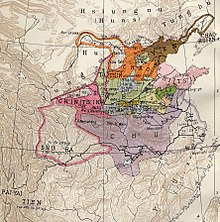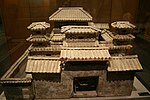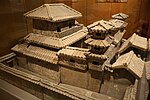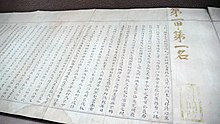
The Qing dynasty, officially the Great Qing, was a Manchu-led imperial dynasty of China and the last imperial dynasty in Chinese history. The dynasty, proclaimed in Shenyang in 1636, seized control of Beijing in 1644, which is considered the start of the dynasty's rule. The dynasty lasted until 1912, when it was overthrown in the Xinhai Revolution. In Chinese historiography, the Qing dynasty was preceded by the Ming dynasty and succeeded by the Republic of China. The multi-ethnic Qing dynasty assembled the territorial base for modern China. It was the largest imperial dynasty in the history of China and in 1790 the fourth-largest empire in world history in terms of territorial size. With over 426 million citizens in 1907, it was the most populous country in the world at the time.
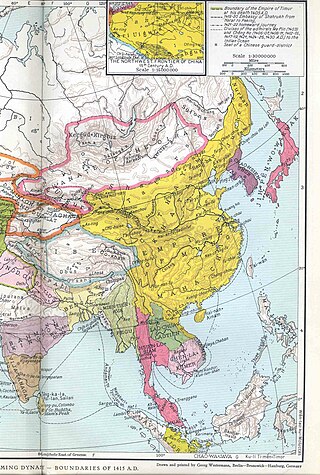
The Ming dynasty, officially the Great Ming, was an imperial dynasty of China, ruling from 1368 to 1644 following the collapse of the Mongol-led Yuan dynasty. The Ming dynasty was the last imperial dynasty of China ruled by the Han people, the majority ethnic group in China. Although the primary capital of Beijing fell in 1644 to a rebellion led by Li Zicheng, numerous rump regimes ruled by remnants of the Ming imperial family—collectively called the Southern Ming—survived until 1662.
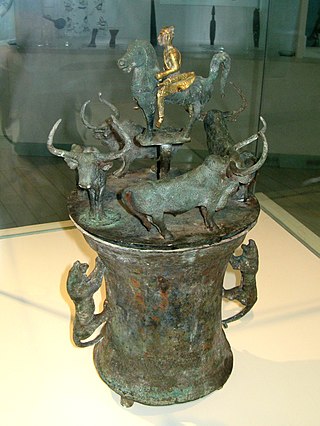
This article describes the history of Yunnan, currently a province of the People's Republic of China.
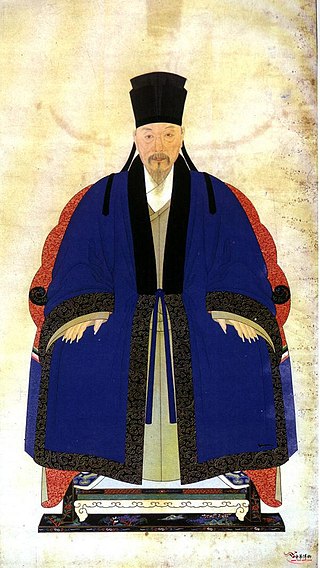
Beizi, also known as beizi and chuozi, is an item worn in traditional Chinese attire common to both men and women; it is typically a large loose outer coat with loose and long sleeves. It was most popular during the Song dynasty, Ming dynasty, and from the early Qing to the Mid-Qing dynasty. The beizi originated in the Song dynasty. In the Ming dynasty, the beizi was referred as pifeng. When worn by men, it is sometimes referred as changyi, hechang, or dachang when it features large sleeves and knotted ties at the front as a garment closure.
The Three Departments and Six Ministries system was the primary administrative structure in imperial China from the Sui dynasty (581–618) to the Yuan dynasty (1271–1368). It was also used by Balhae (698–926) and Goryeo (918–1392) and various other kingdoms in Manchuria, Korea and Vietnam.

The Yuan dynasty, officially the Great Yuan, was a Mongol-led imperial dynasty of China and a successor state to the Mongol Empire after its division. It was established by Kublai, the fifth khagan-emperor of the Mongol Empire from the Borjigin clan, and lasted from 1271 to 1368. In Chinese history, the Yuan dynasty followed the Song dynasty and preceded the Ming dynasty.
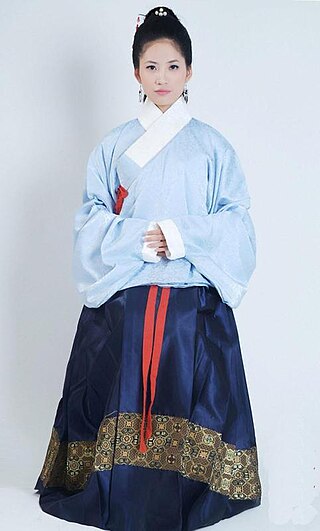
Ruqun is a set of attire in Hanfu which consists of a short jacket typically called ru worn under a long Chinese skirt called qun. However, when use as a general term, ruqun can broadly describe a set of attire which consists of a separated upper garment and a wrap-around lower skirt, or yichang, in which yi means the "upper garment" and the chang means the "lower garment". In a broad sense, ruqun can include the shanqun and aoqun in its definition.
The history of the Qing dynasty began with the proclamation of the Qing dynasty by the Manchu chieftain Hong Taiji in 1636, but the year 1644 is generally considered the start of the dynasty's rule in China. The dynasty lasted until 1912, when Puyi abdicated the throne in response to the 1911 Revolution. The final imperial dynasty of China, the Qing dynasty reached heights of power unlike any of the Chinese dynasties which preceded it, engaging in large-scale territorial expansion which ended with embarrassing defeat and humiliation to the foreign powers whom they believe to be inferior to them. The Qing dynasty's inability to successfully counter Western and Japanese imperialism ultimately led to its downfall, and the instability which emerged in China during the final years of the dynasty ultimately paved the way for the Warlord Era.
Dragon robes, also known as gunlongpao or longpao for short, is a form of everyday clothing which had a Chinese dragon, called long (龍), as the main decoration; it was worn by the emperors of China. Dragon robes were also adopted by the rulers of neighbouring countries, such as Korea, Vietnam, and the Ryukyu Kingdom.

The Qing dynasty (1644–1912) was established by conquest and maintained by armed force. The founding emperors personally organized and led the armies, and the continued cultural and political legitimacy of the dynasty depended on their ability to defend the country from invasion and expand its territory. Therefore, military institutions, leadership, and finance were fundamental to the dynasty's initial success and ultimate decay. The early military system centered on the Eight Banners, a hybrid institution that also played social, economic, and political roles.

Late Qing reforms, commonly known as New Policies of the late Qing dynasty, or New Deal of the late Qing dynasty, simply referred to as New Policies, were a series of cultural, economic, educational, military, diplomatic, and political reforms implemented in the last decade of the Qing dynasty to keep the dynasty in power after the invasions of the great powers of the Eight Nation Alliance in league with the ten provinces of the Southeast Mutual Protection during the Boxer Rebellion.

The administration of territory in dynastic China is the history of practices involved in governing the land from the Qin dynasty to the Qing dynasty (1644–1912).
The fashion in the Yuan dynasty of Mongol (1271–1368) showed cultural diversity with the coexistence of various ethnic clothing, such as Mongol clothing, Han clothing and Korean clothing. The Mongol dress was the clothing of elite for both genders. Mongol attire worn in the 13th-14th century was different from the Han clothing from the Tang and Song dynasties. The Yuan dynasty court clothing also allowed the mixed of Mongol and Han style, and the official dress code of the Yuan dynasty also became a mixture of Han and Mongol clothing styles. After the founding of the Yuan dynasty, the Mongols strongly influenced the lifestyle and customs of the Han people.

Jisün, also known as zhisunfu or Zhisun, zhixun, jixun, zhama or Jisun, was a very important male Mongol garment during the Yuan dynasty. They were also known as Mongol "robes of honour" (khil'at). The zhisun was a form of ceremonial clothing, which was worn during the jisün banquets, which were the most important ceremony of the Yuan dynasty court. The zhisun were made of textile woven with gold and silk of one colour. In China, the zhisun was introduced during the Yuan dynasty and was inherited by the Han Chinese during the Ming dynasty. In both the Yuan and Ming dynasty, the zhisun is a single-coloured court robe. The zhisun is a type of Mongol terlig.
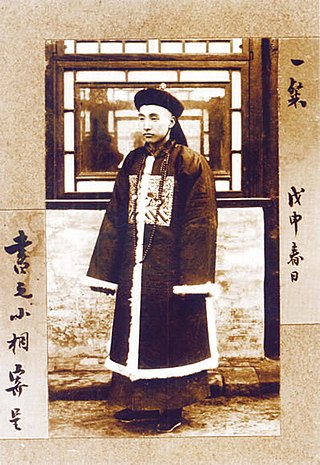
The Qing dynasty (1644–1912) was the last imperial dynasty of China. The early Qing emperors adopted the bureaucratic structures and institutions from the preceding Ming dynasty but split rule between the Han and Manchus with some positions also given to Mongols. Like previous dynasties, the Qing recruited officials via the imperial examination system until the system was abolished in 1905. The Qing divided the positions into civil and military positions, each having nine grades or ranks, each subdivided into a and b categories. Civil appointments ranged from an attendant to the emperor or a grand secretary in the Forbidden City (highest) to being a prefectural tax collector, deputy jail warden, deputy police commissioner, or tax examiner. Military appointments ranged from being a field marshal or chamberlain of the imperial bodyguard to a third class sergeant, corporal or a first or second class private.
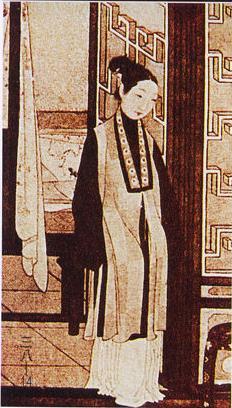
Bijia is a long, sleeveless jacket of Mongol origins which has opened side slits. The bijia started to be worn in the Yuan dynasty when it was designed by Empress Chabi. The bijia eventually became one of the most typical form of women's clothing item in the Ming dynasty and in the Qing dynasty. It is also a type of hanfu which has been revived in present days.

Feiyufu, also called feiyu mangyi, is a type of traditional Han Chinese clothing which first appeared in the Ming dynasty. It is also specific name which generally refers to a robe decorated with the patterns of flying fish. The feiyufu worn by the Ming dynasty imperial guards reappeared in the 21st century following the hanfu movement and is worn by Hanfu enthusiasts of both genders.

Ru, sometimes referred to as shan, ao, and yi, is a form of traditional Chinese upper garment, or coat, or jacket, which typically has a right closure; however, they may also have a front central opening. It is traditional everyday wear for women of the Han Chinese ethnic group. It can be worn in combination with a skirt in a style called ruqun, or a pair of trousers in a style called shanku.
Tifayifu was a cultural policy of the early Qing dynasty as it conquered the preceding Ming dynasty. In 1645, the Tifayifu edict forced Han Chinese people to adopt the Manchu hairstyle, the queue, and Manchu clothing. The edict specifically applied to living adult men, who did not fall in the stipulated exceptions. In 1644, on the first day when the Manchu penetrated the Great Wall of China in the Battle of Shanhai Pass, the Manchu rulers ordered the surrendering Han Chinese population to shave their heads; however, this policy was halted just a month later due to intense resistance from the Han Chinese near Beijing. Only after the Manchu captured Nanjing, the southern capital, from the Southern Ming in 1645 was the Tifayifu policy resumed and enforced severely. Within one year after entering China proper, the Qing rulers demanded that men among their newly defeated subjects adopt the Manchu hairstyle or face execution. The Qing prince regent Dorgon initially canceled the order to shave for all men in Ming territories south of the Great Wall. The full Tifayifu edict was only implemented after two Han officials from Shandong, Sun Zhixie and Li Ruolin, voluntarily shaved their foreheads and demanded that Dorgon impose the queue hairstyle on the entire population.

Qizhuang, also known as Manfu and commonly referred as Manchu clothing in English, is the traditional clothing of the Manchu people. Qizhuang in the broad sense refers to the clothing system of the Manchu people, which includes their whole system of attire used for different occasions with varying degrees of formality. The term qizhuang can also be used to refer to a type of informal dress worn by Manchu women known as chenyi, which is a one-piece long robe with no slits on either sides. In the Manchu tradition, the outerwear of both men and women includes a full-length robe with a jacket or a vest while short coats and trousers are worn as inner garments.
